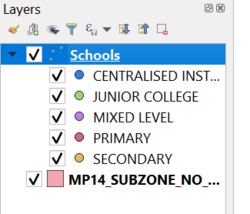Difference between revisions of "SMT201 AY2019-20T1 EX1 Wang Youjin"
| Line 65: | Line 65: | ||
<br> | <br> | ||
| − | } | + | |} |
== Part 2: Choropleth Mapping == | == Part 2: Choropleth Mapping == | ||
Revision as of 18:50, 15 September 2019
Part 1: Thematic Mapping
Explain how the mapping were developed with elaboration:
| Data | QGIS Techniques |
|---|---|
| 1.data.gov - “School Directory and Information” |
New Layer created: Schools created from csv file using Geocoding tool MMQGIS plugin. 'Address' attribute is used for openstreet map projection Distribution of school types: Under Symbology, select categoriszation by `mainlevel_` attribute.Different colors are used to indication different school types for easy illustrative reference purpose School types
Data not found CSV from geocoding: |
| 2.data.gov - “Masterplan 2014 Landuse” "National Map Line"
SLA - "Road Selection Line" |
Layer Imported: Land Use, Road Selection Line, National Map Line Different color lines and width are used to represent different types of road with cateogirized technique performed on the map line layer use Road Network
|
| 3. data.gov - “MP14_SUBZONE_NO_SEA_PL” | Layer: MP14_SUBZONE_NO_SEA_PL
Categorization technique is used to indicate the land used for different purpose. <brt Land Use
|
Part 2: Choropleth Mapping
[[File:|center]]
FIGURE VIII
LAYERS EXPORTED
The choropleth mapping developed uses these following data and applied techniques:
Sources and Methods
| Dataset | Visualisation & Processing Technique |
|---|---|
| “Singapore Residents by Planning Area/Subzone, Age Group and Sex, June 2000 - 2018” from Department of Statistics Singapore. |
Layer: respopagsex2000to2018_unfiltered Processing: 1. [[File: |center|600px]] FIGURE IX FILTERING AGED POPULATION 2. .
FIGURE X AGGREGATING DATA USING GROUPSTATS
FIGURE XI IMPORTING GROUPSTATS GENERATED CSV USING CUSTOM DELIMITER s: a. `is. b. ones. [[File:|center|400px]] FIGURE XII DATA OVERVIEW OF IMPORTED GROUPSTATS DATA
[[File:|center|400px]] FIGURE XIII DATA OVERVIEW OF IMPORTED GROUPSTATS DATA 4. Led. 5. We [[File:|center|400px]] FIGURE XIV PROPORTION FIELD CREATION
a. [[File:|center|300px]] FIGURE XV DERIVING PERCENTAGE CHANGE 6. L
|
| Singapore Master Plan 2014 Subzone and Planning Area 2014 boundary data retrieved from data.gov |
1. `SumAgedPopulation2010_PA` layer joined with `sum_aged_pop_2010_pa` by matching attribute `PLN_AREA_N` and `Zone_ID_PA`. a. Symbology (Natural Jenks): [[File:|center|400px]] FIGURE XVI CATEGORISATION OF PLANNING AREA SUM AGED POPULATION DATA
[[File:|center|400px]] FIGURE XVII CATEGORISATION OF PLANNING AREA SUM AGED POPULATION DATA
[[File:|center|400px]] FIGURE XVIII CATEGORISATION OF SUBZONE SUM AGED POPULATION DATA 4. `SumAgedPopulation2018_SZ`layer joined with `sum_aged_pop_2018_sz` by matching attribute `SUBZONE_N` and `Zone_ID_SZ`. a. Symbology (Natural Jenks): [[File:|center|400px]] FIGURE XIX CATEGORISATION OF SUBZONE SUM AGED POPULATION DATA 5. `ProportionAgedPopulation2010_SZ` layer joined with `propotion_aged_pop_2010` by matching attribute `SUBZONE_N` and `Zone_ID_SZ`. a. Symbology (Natural Jenks):
FIGURE XX CATEGORISATION OF SUBZONE PROPORTION AGED POP DATA 6. `ProportionAgedPopulation2018_SZ` layer joined with `propotion_aged_pop_2018` by matching attribute `SUBZONE_N` and `Zone_ID_SZ`. a. Symbology (Natural Jenks): [[File:|center|400px]] FIGURE XXI CATEGORISATION OF SUBZONE PROPORTION AGED POP DATA 7. `Percentage_Change_SZ` layer joined with `2010_2018_percentage_change` by matching attribute `SUBZONE_N` and `Zone_ID_SZ`. a. Symbology: Below is the configuration used for percentage change of aged population. The legend classification intervals were split into 2 ways, negative changes which represents a decrease change were categorised using an equal distribution from the minimum decrease value of -100% to 0. Next, Natural Breaks (Jenks) were used to classify the 5 next categories for the positive values to indicate. Due to its high variance value, the Jenks classification represents best for this case. Additionally, 2 distinct colours (red and blue) were used to appropriately display the nature of percentage change of the aged population from 2010 to 2018. [[File:|center|500px]] FIGURE XXII CATEGORISATION OF SUBZONE PERCENTAGE CHANGE DATA [[File:|center|500px]] FIGURE XXIII 3 BASE COLOR PICK FOR SUBZONE PERCENTAGE CHANGE DATA
FIGURE XXIV DATA LABELLING For
FIGURE XXV CATEGORISATION OF SUBZONE PERCENTAGE CHANGE DATA
|


